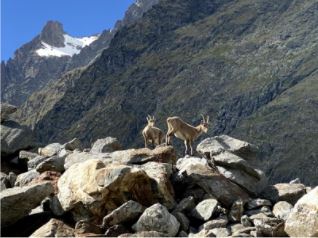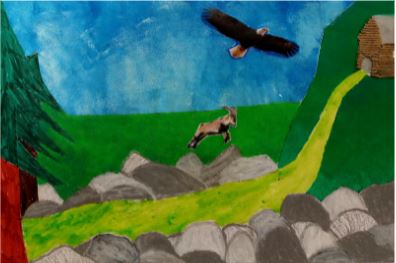Author: class II A (grade 7), I.S. Abbé J.M. Trèves, Saint-Vincent, Vallée d'Aoste (IT),
PARTNERS: class II B (grade 7), I.S. Abbé J.M. Trèves, Saint-Vincent, Vallée d' Aoste (IT); class grade V, CEIP Plurilingue Espiñera Aldán (ES).
Introduction

Alpine ibex, Val Veny (own photo)
This seedquest has been created to allow students to come to know the topic of biodiversity in an active way: they will search information on the web and then organize and present them to their schoolmates.
They will learn an original way to tell stories, the “Kamishibai”, searching for examples and models and then realizing their own “figures”.
They will be called to put themselves out there and to contribute actively in the activity: it will be a real team play, in which someone will deal with the scientific side of the matter, others will write the “screenplay” and the rest will care about the artistic part.
Learning Objectives
- Understand the importance of biodiversity for many different reasons
- Learn new information about the environment, the animals and plants of our region
- Teamwork
- Experience an original storytelling technique, the kamishibai
- Use different languages
Task

A Kamishibai to tell the story of biodiversity (photo from a student's drawing)
|
The task is to create a kamishibai about a short story written by students, illustrating a particular aspect of biodiversity in our alpine region. Students will search information on the web, then organize it, use it to create a short kamishibai story and finally illustrate and perform it. They will work in groups, sharing the same objectives, contributing in different ways. |
Process
More models of Kamishibai in: |
Evaluation
- What biodiversity means, why it is so important
- How to preserve biodiversity
- What is a kamishibai
- Search and select info on the web
- Translate info into a short story to share ideas
- Illustrate a text in a meaningful way, using different techniques
- Work in team in a collaborative way
- Learn how to learn: find and organize info about a new topic
- Multilingual competences
- Entrepreneurship competence: create an original product by using different sources and skills
Conclusion
The class generally appreciated the activity, maybe because it was an active approach. It is a long and articulated activity, so a disadvantage is that some students lose their interest on the topic during the different steps.
The final product was appreciated by students, they were generally satisfied, in particular with the graphic output.
Links
General information to study biodiversity
https://www.wwf.it/il_pianeta/biodiversita/che_cosa_e_biodiversita/ https://www.fondazioneslowfood.com/it/i-nostri-temi/biodiversita/
The Alps
http://www.pngp.it/; http://osservatoriobiodiversita.regione.vda.it/Osservatorio_Biodiversita/page1.do?sp=page2
The Alps
https://www.montavic.it/ https://www.regione.vda.it/territorio/ambiente/Biodiversita_e_aree_naturali_protette/Aree_naturali_protette/Riserve_naturali/default_i.aspx
Models of Kamishibai
https://www.dulala.fr/kamishibais-numeriques/ https://kamilala.org/wp-content/uploads/2020/09/NAT-ET-SON-VOYAGE.pdf https://kamilala.org/wp-content/uploads/2019/05/kamishibai-c3-kam14.pdf https://kamilala.org/wp-content/uploads/2020/08/Vall%C3%A9e-dAoste-Il-y-a-une-paire-de-scarpette-rosse.pdf








